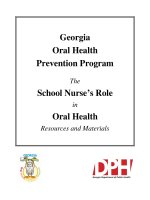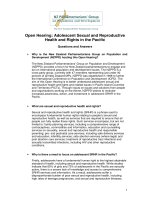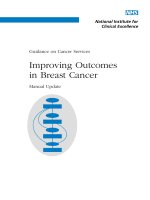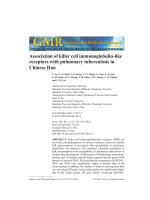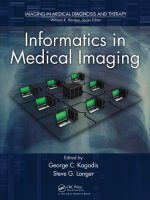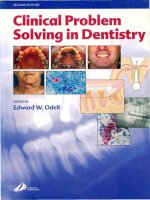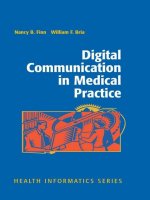Restorative Techniques in Paediatric Dentistry pdf
Bạn đang xem bản rút gọn của tài liệu. Xem và tải ngay bản đầy đủ của tài liệu tại đây (8.93 MB, 163 trang )
Restorative Techniques in Paediatric Dentistry
An Illustrated Guide to the Restoration of Carious Primary
Teeth
Second Edition
M S Duggal BDS, MDS, FDSRCS, PhD
M E J Curzon BDS, MSc, PHD, FRCD(C), FDSRCS
S A Fayle BDS, MDSc, FRCD(C), FDSRCS
K J Toumba BSc(Hons), MSc, BChD, PhD, FDSRCS
A J Robertson BSc, DIPIMI, FIMI, RMIP
Paediatric Dentistry, Division of Child Dental Health Leeds Dental Institute, University of
Leeds, Leeds, England
MARTIN DUNITZ
1994, 2002 Martin Dunitz Ltd, a member of the Taylor & Francis group
First published in the United Kingdom in 1994
by Martin Dunitz Ltd, The Livery House, 7–9 Pratt Street, London NWI 0AE
Tel: +44 (0) 20 74822202
Fax: +44 (0) 20 72670159
E-mail:
Website:
This edition published in the Taylor & Francis e-Library, 2004.
Second edition 2002
All rights reserved. No part of this publication may be reproduced, stored in a retrieval
system, or transmitted, in any form or by any means, electronic, mechanical, photocopying,
recording, or otherwise, without the prior permission of the publisher or in accordance with
the provisions of the Copyright, Designs and Patents Act 1988 or under the terms of any
licence permitting limited copying issued by the Copyright Licensing Agency, 90 Tottenham
Court Road, London WIP OLP.
Although every effort has been made to ensure that drug doses and other information are
presented accurately in this publication, the ultimate responsibility rests with the prescribing
physician. Neither the publishers nor the author can be held responsible for errors or for
any consequences arising from the use of information contained herein. For detailed
prescribing information or instructions on the use of any product or procedure discussed
herein, please consult the prescribing information or instructional material issued by the
manufacturer.
A CIP record for this book is available from the British Library.
ISBN 0-203-64586-3 Master e-book ISBN
ISBN 0-203-69355-8 (OEB Format)
ISBN 1-85317-592-7 (Print Edition)
Distributed in the United States and Canada by:
Thieme New York
333 Seventh Avenue
New York, NY 10001
Distributed in the rest of the world by:
ITPS Limited
Cheriton House
North Way
Andover, Hampshire SP10 5BE, UK
Tel: +44 (0) 1264 332424
E-mail:
Composition by Scribe Design, Gillingham, Kent
Contents
Foreword
vii
Preface
ix
Acknowledgements
x
1
Treatment Planning
M E J Curzon & M S Duggal
1
2
Local Analgesia
S A Fayle & M S Duggal
13
3
Rubber Dam
S A Fayle & M S Duggal
29
4
Pulp Therapy for Primary Teeth
M S Duggal & M E J Curzon
45
5
Stainless Steel Crowns for Primary Molars
M S Duggal & M E J Curzon
75
6
Strip Crowns for Primary Incisors
K J Toumba & S A Foyle
95
7
Plastic Restorations for Primary Teeth
M S Duggal & K J Toumba
103
8
Comprehensive Care: Examples of Treated Cases
E A O’Sullivan & K J Toumba
115
Further Reading
133
Index
137
Foreword
Clinical paediatric dentistry is a demanding subject. This book by Professor Monty Duggal
and colleagues concentrates on a very important issue in the clinical treatment of children—
the rational restoration of carious primary teeth. Despite effective preventive programmes,
which have resulted in a tremendous improvement in the oral health of children and
adolescents, in any population there will always be a group of children with a high caries
activity resulting in extensive carious lesions. The successful treatment of such children,
especially with regard to primary dentition, is a very difficult and complicated task. A golden
rule in the treatment strategy for this group is to perform all clinical procedures to such a high
standard that retreatment is unnecessary and no further work should be needed on the tooth
before normal exfoliation.
This philosophy is the backbone of this book, which presents a detailed step-by-step guide to
help the reader reach the required level of excellence for the treatment of extensively carious
primary teeth. Using first-class photographic material, all the important procedures are
described in an impressive and instructive way, and useful comments on the scientific
background and prognosis are provided. There are detailed chapters on treatment planning,
local analgesia, rubber dam technique, pulp therapy for primary teeth, stainless steel crowns
and strip crowns for primary incisors. This information is consolidated in the last chapter by
means of a number of case reports.
The authors are to be congratulated on an excellent book that should be read and reread by all
those aiming to perform high-quality paediatric dentistry, which is cost-effective both for the
dentist and the patient and has long-term preventive implications. I warmly recommend this
book and believe that it will be well accepted by the dental profession.
Göran Koch
Odont dr., Professor
Chairman Pediatric Dentistry
The Institute for Postgraduate Dental Education
Jönköping, Sweden
Acknowledgements
The preparation of an atlas such as this has involved many of our colleagues and postgraduate
students. Some of the illustrations used here have been gleaned from the presentation cases of
our postgraduates as part of their masters degree examinations, from undergraduate treatment
cases and from our own patients.
We are particularly grateful to our colleagues who have helped with the preparation of the
illustrations and text. Our postgraduate students were very understanding when we
photographed procedures while they were treating their patients. Inevitably this slowed up the
treatment.
Over the past few years, we have been indebted to the members of the Medical and Dental
Illustration Department at Leeds who have taken many pictures of our patients for teaching
purposes. Some of this material has also been included here. We would like to acknowledge
John Walker and Maria Clarke for their excellent photography and also for their support in
spite of their busy schedules. Thanks also to Joyce Hindmarsh for duplicating all of the
radiographs used here, and also Anna Durbin for illustrations. We are also grateful to Robert
Peden of Martin Dunitz, who patiently kept chasing us for the final manuscript.
1
Treatment Planning
Children as individuals
A treatment plan must be developed and designed to provide high-quality restorative care for
each individual child’s needs. The details will vary according to the types of restorations
needed, as will the sequence of placing restorations.
In this book the objective is to provide an atlas describing the techniques for the restorative
care of children, and therefore the approach to treatment planning is very much orientated to
that end. It is accepted that every child will require some degree of preventive dentistry and
behaviour management, but these subjects will not be covered here.
Quality care for children
Children are the future dental patients and the dental care that they receive should therefore
promote positive dental experiences, which, in turn, promotes positive dental attitudes. It
makes disturbing reading when some dental professionals, particularly in the UK, question
whether children’s teeth should be restored at all. We feel that this type of thinking, promoted
usually by some public health dentists, rather than paediatric dentists, is more to do with
economics than conviction. There can be no doubt that untreated caries in the primary
dentition can cause abscesses, pain and suffering in children. Indeed, hospital-based
consultants in paediatric dentistry frequently deal with patients referred to them with severe
infections related to long-standing untreated caries in the primary dentition of children who
have had regular check-ups with their dentist (Figure 1.1). These children then require
hospital admissions and treatment under general anaesthesia, whereas a simple restoration at
the time when the caries was diagnosed would have prevented this extremely distressing
episode for the child. There are also implications for costs of carrying out this hospital-based
treatment, which is substantially more than the cost of simple restorative and preventive
treatment. In addition, a negative dental experience for a young child could alter their attitude
to dentistry and dental health for life. It is therefore essential for all dentists involved in the
care of young children
Figure 1.1 Photograph of a young child with severe infection resulting from an unrestored carious
upper second primary molar.
to learn restorative techniques that give the best results in primary teeth. This approach,
alongside excellent preventive programmes, would form the basis of ‘quality dental care for
children’, which this book seeks to promote. Good quality restorative care, as and when
caries is diagnosed, would also obviate the need for extractions of primary teeth under
general anaesthesia for thousands of children, particularly in the UK, a practice that should
have only a small place in the dental care of young children.
Figure 1.2 Dental history form.
Philosophy of treatment planning
In planning for the restoration of teeth, allowance must be made for two types of children.
The first will be those for whom no restorative care has been attempted in the past, but who
now do need it. For these children a sequenced introduction to the procedures of restoring
teeth is needed. Treatment planning for them must include a step-by-step introduction to the
use of pain control (local analgesia), use of rotary instruments, rubber dam and the placing of
restorations. The time needed for this introduction may be anything from a few minutes to
several visits.
Most children will not normally be afraid, and one of the important aspects of providing care
for them will be to ensure that they do not develop a fear of dentistry.
The second group of children comprises those who may already have had some restorations
or perhaps attempted restorations. With these children there may be a history of being totally
uncooperative or only reluctant to cooperate but persuadable. In such cases the treatment
planning must take into account the degree of cooperation and again an amount of time
allowed for behaviour modification.
In this atlas it is assumed that a child is cooperative or that cooperation has been obtained.
The technique of treatment planning is to obtain all the necessary information on the dental
history and dental status of a child. Using this information, a plan of dental visits is drawn up
so as to complete the restorative care needed in the shortest possible time appropriate for that
child. It is our philosophy that the ideal approach for restoring children’s teeth involves the
practice of quadrant dentistry.
Diagnosis
The dental problems of a child must be assessed before a treatment plan is designed. This
involves not only examining the teeth but also assessing the child’s behaviour. This should
start before the child has entered the dental office and should begin by observing the child
with his or her parents or carers in the waiting room. As the family enter, the child’s
behaviour and relationship with parents or carers should be observed. It is at this stage that
any apprehension or difficult behaviour should be noted, since it will affect the sequence of
restorative procedures and hence the treatment plan.
A history should be taken from the parents, including details of previous behaviour,
restorations or attempted restorations. In addition, the parents should be asked if previous
restorative work has been with or without local analgesia and rubber dam. Any previous
history of extractions, again with either local analgesia or general anaesthesia, should be
noted. These details should be recorded on a dental history form (
Figure 1.2).
The first visit will include a simple examination of the dentition, with an assessment of the
extent of dental caries, oral hygiene, gingivitis and periodontal disease. All oral tissues should
be examined for health and possible pathology. Before restorative care is started, the oral
hygiene should be of a good standard, and the child’s behaviour should have been assessed
and measures taken to ensure cooperation.
Dental caries assessment
For the restoration of primary and young adult teeth, the extent of dental caries must be
known. A clinical examination with a dental mirror and good lighting is required, with a dry
field. The presence of all carious lesions and restorations must be recorded on a suitable
dental chart. If available, transillumination is also helpful.
In particular, the following should be noted about the dental caries in each tooth:
•
staining of pits and fissures;
•
discolouration of the enamel;
•
condition of the marginal ridge, whether intact or broken (Figure 1.3).
Figure 1.3 Photograph of primary molars showing broken marginal ridge. Where over one-third of
the marginal ridge has been lost, pulpal involvement has occurred and pulp treatment (pulpotomy or
pulpectomy) should be planned (see
Chapter 4).
Figure 1.4 Photograph of primary molars showing a draining sinus on a first primary molar with a
failed glass ionomer restoration. This tooth must be treated with a pulpectomy (see
Chapter 4).
Figure 1.5 Photograph of a primary molar with a failed glass ionomer cement restoration, now
requiring pulp treatment and a preformed metal crown (see Chapters
4 and 5).
At the same time, the presence of chronic or acute abscesses should be noted, as well as
draining sinuses, which would indicate pulpal pathology (Figure 1.4).
Existing restorations should be examined with care for recurrent caries and for the type and
integrity of the restorations. In particular, glass ionomer cements and composite resin
restorations
Figure 1.6 Photograph showing decayed primary maxillary incisors due to nursing bottle caries.
These can be restored with strip crowns (see
Chapter 6).
should be examined most critically, since their success rates in primary teeth are poor and
they often need replacement. An example of a poor quality glass ionomer restoration in a
primary molar that has failed is shown in Figure 1.5. Too often, an attempt is made to restore
a large cavity in a primary tooth with a material that will not hold for very long. Leakage
around the margins or breakdown of the margins leads to failure of the restoration. In many
cases the cavity was originally quite deep, and irreversible pulpal necrosis occurs when the
tooth dies and an abscess ensues. This is the situation illustrated in Figure 1.5.
Attention should also be paid to the state of the primary incisors. When childhood caries has
occurred, an assessment of the possibility of restoring these teeth should be made. In most
cases even quite badly broken teeth can be restored with strip crowns, as long as there is
sufficient coronal dentine and enamel left. Even four badly decayed maxillary incisors
(
Figure 1.6) can be retained.
Dental charting
The condition of all teeth should be recorded on a suitable chart. It is important that all teeth,
existing restorations (of no matter what quality) and sites of dental caries must be charted.
The presence of sound restorations should also be recorded (usually in blue or black) as
should all dental caries (in red).
Any stained, discoloured or broken marginal ridges, stained pits and fissures, abscesses or
sinuses should also be noted, on the chart. Fractured teeth (incisors) should be recorded,
although their restoration is not dealt with in this book.
Accurate dental records for dental caries and restorations are needed prior to drawing up a
treatment plan, but are also essential for medico-legal requirements. A complete charting
should also be completed at each recall visit when a new course of care is planned. This
should be done even if no new restorative procedures are indicated.
An intra-oral charting together with diagnostic quality radiographs and other diagnostic tests
enable a logical treatment plan to be drawn up.
The details of the treatment plan, with an outline of the number of treatment visits, should be
discussed with the child’s parents. This is essential, because the success of the treatment will
be dependent on parental enthusiasm and support. If a parent is not willing to bring the child,
or cannot afford the necessary costs in time and money, then an alternative plan will need to
be drawn up. However, for our purposes we have assumed that all treatment is accepted by
the parent or carer, and restorative work can be completed with the cooperation of parent and
child.
It is recommended that once a treatment plan has been agreed with the parent that it be signed
by him or her. This is particularly important when financial payment is involved.
Radiographs
The importance of radiographs for the diagnosis of caries in children cannot be
overemphasized, as
Figure 1.7 A bitewing radiograph showing a medium-sized distal lesion in 84, which was only
diagnosed because radiographs were taken and would not have been diagnosed on clinical
examination alone.
Figure 1.8 Bitewings are also essential for the diagnosis of occlusal caries, (a) Clinical photograph
showing a fissure sealant on the 85 that had been placed on a previous visit to the dentist without
bitewing radiographs being taken before its placement. Shadowing is evident around the sealed area,
(b) Bitewing radiograph showed large occlusal caries below the sealant, (c) This then required pulp
therapy and a stainless steel crown on the 85.
clinical examination alone would mean that many early lesions will be missed (Figures 1.7
and 1.8). In the authors experience several dentists have been sued for failing to take
radiographs for children under their care for several years and, consequently, for not
diagnosing caries before it became symptomatic. It is not possible to diagnose early occlusal
or proximal caries by clinical examination alone. Whilst several techniques have been
introduced recently, most notable of which is
Figure 1.9 Scheme for deciding when to take bitewing radiographs of a child based upon dental caries
experience.
Diagnodent (KAVO), bitewing radiography is by far the most acceptable and widely
available for use in general practice. Radiographs should form a routine part of dental
examination and it is necessary to repeat radiographs for dental caries diagnosis at
intervals. This will depend on the caries history of the child. There are no hard and fast rules
regarding the intervals for the taking of bitewing radiographs, but one suggested scheme is
shown in Figure 1.9. This is based upon the past caries history of a child and indicates
whether bitewings are needed at 6- or 12-month intervals for the primary dentition. As the
caries history of a child develops, it becomes necessary to reassess the need for radiographs at
each recall examination. If a child does not develop new caries lesions then the interval
between taking bitewing radiographs should be increased. A good approach requires two
recall examinations without new carious lesions before this is done.
After one year (two recalls) without new lesions, the bitewing interval is increased to one
year. After a further year without any evidence of dental caries, the interval is increased to 18
months. However, if at any time new caries is diagnosed or there is caries around restorations
then the interval between bitewing radiographs is returned to six months.
This approach is used not only for the primary dentition but also for the mixed and permanent
dentitions, as indicated in
Figure 1.9.
The set of radiographs taken for a child at any one course of dental care will vary according
to the needs and age of the child. At least one orthopantomogram or its equivalent should be
available at least once during the development stage of the dentition (age 6 years). Bitewings
and/or peri-apical views are also appropriate. Two suggested sequences of radiographs are
shown in Figures 1.10 and 1.11.
Figure 1.10 A typical sequence of radiographs for a preschool child, comprising an
orthopantomogram and a set of bitewings. These views are designed to show all alveolar bone
structures, development of primary and secondary teeth, and peri-apical or furcation pathology
associated with the primary teeth and bone and other structures of the maxilla and mandible.
Bitewings show the presence/absence of dental caries.
Choice of restoration
The type of restoration used for a primary tooth will depend on:
•
the tooth to be restored;
•
past caries history;
•
child cooperation.
An important consideration in restoring primary teeth, as with all teeth, is that a tooth should
only need restoring once. A need for repeated restoration of a primary tooth indicates bad
dental care. The cooperation of a child may well deteriorate if for every course of treatment
the same teeth need restoration. It will also not encourage confidence on the part of the parent
if teeth have to be restored repeatedly.
Various research groups have studied the longevity or failure rate of restorations of primary
teeth. Our own work on this (
Figure 1.12) has shown that where there has been caries on at
least two surfaces or a marginal ridge has broken, the preformed metal crown (stainless steel
crown) is the restoration of choice. Amalgam at present is a valuable restorative material in
the primary dentition, and is indicated for one-surface or small two-surface restorations.
It is clear from
Figure 1.12 that composite resin restorations and glass ionomer cements under
clinical conditions did not survive beyond 48 months (four years) out of the possible five
years covered by the study. Other researchers have found similar results. On this basis, our
present recommendation is that great care must be taken when composite resins and glass
ionomer cements are used for primary molars.
Both composite resins and glass ionomer cements are technique-sensitive, and ideally need to
be placed under rubber dam. Therefore these types of restorations are recommended for small
single surfaces only. Glass ionomer cements can be used as semi-permanent restorations in
primary molars when the teeth are close to exfoliation. Alternatively, glass ionomer cements
may be used as a temporary measure for a few months until a permanent restoration can be
placed.
Figure 1.11 A suggested sequence of radiographs for a child of school age who has already had a
number of restorative procedures. The bitewings serve to diagnose new or recurrent caries, while the
peri-apical views are usually taken of the primary molars for pathology secondary to pulp therapy.
Figure 1.12 Survival rate of various types of restorations in primary teeth over a period of five years.
Restorations were placed by staff and students in a dental school paediatric dental clinic. SSC,
preformed metal crown; amalgam, amalgam restoration; composite, composite resin; GPC, glass
ionomer cement.
Local analgesia
It is our philosophy that local analgesia should be routinely used in the restoration of primary
teeth. In a cooperative child there are no contraindications for its use other than very young
age (below approximately 2 1/2 years). There is also no contraindication to the use of a
mandibular block in children, although we advocate the use of the ‘rule of 10’ to determine
whether a block or an infiltration is used for primary mandibular molars. This approach takes
the age of the child plus the number of the tooth (canine=3, first molar=4, second molar=5).
If this is more than 10 then a mandibular block is needed. If it is less than 10 then an
infiltration is appropriate. Thus if a restoration is required in a second molar in a 3-year-old,
(5+ 3=8) then an infiltration is indicated. However, it is the authors’ opinion that for pulp
therapy in mandibular, block analgesia should be used.
We strongly advocate the use of topical analgesia with a flavoured benzocaine cream. A
number of flavours (mint, cherry, bubblegum etc.) are available and have the advantage that
they enable the child to have a choice, and therefore a degree of participation, in restoring
their teeth. This can be very important as part of the behaviour management of the child.
A short-acting analgesic should be used, such as prilocaine, which provides a sufficient
duration of analgesia (30–45 minutes) to accomplish the necessary restorations in a quadrant.
At the same time, the soft tissue analgesia should be wearing off by the time the child leaves
the dental office.
The use of local analgesia in children is described more fully in
Chapter 2.
Rubber dam
Rubber dam is the technique most widely advocated in dental teaching—yet the most widely
neglected in dental practice. However, we believe that the restoration of primary teeth should
always, as far as possible, be carried out under rubber dam. It is essential for pulp therapy,
and highly desirable if quadrant dentistry is to be accomplished.
Order of restorations
It is important to start restorative treatment with the easiest local analgesia, which will be an
infiltration. Therefore a maxillary quadrant should be the first choice. A right-handed dentist
should start with the maxillary left, and a left-handed dentist with the maxillary right. The
sequence of quadrants for a right-handed dentist is then:
•
first: maxillary left;
•
second: maxillary right;
•
third: mandibular left;
•
fourth: mandibular right.
If primary incisors are involved then:
•
fifth: maxillary incisors.
This approach would of course start with the right side of the mouth for a left-handed dentist
because of the ease of giving an infiltration local analgesic on the opposite side of the mouth
to where the dentist is sitting.
If primary mandibular incisors are involved then the caries rate is probably so high that a
more radical approach is needed. In such cases multiple extractions are indicated, or else the
approach should be restoration of the dentition under general anaesthesia.
What must be avoided is hasty restoration of badly broken down teeth in the mandible at a
first visit. It is far better to dress teeth with temporary restorations (such as an intermediate
restorative material and a zinc oxide and eugenol cement, e.g. Kalzinol) and to plan the
treatment in such a way as to introduce local analgesia in a controlled and simple manner so
that the child readily accepts the treatment. Obviously an infiltration in the maxilla is easier to
carry out than a mandibular block. Similarly an application of topical analgesic cream is
easier to introduce in the maxilla.
Medical history and treatment planning
The medical history of a child will affect the type of restorative treatments that may be
carried out. Obviously a full medical history should be completed for every child before
dental care commences. Two specific groups of medical problems will affect which of the
techniques described in this book should or should not be carried out.
Bleeding disorders
Extraction of teeth in a child with any form of bleeding disorder is contraindicated.
Accordingly, for these children pulpotomies or pulpectomies are mandatory as long as the
tooth is restorable. Every effort should therefore be made to save the tooth, even to the extent
of trying the various forms of pulp treatment on several occasions.
Heart conditions and immunosuppression
While over a 90% success rate can be achieved with pulpotomies and pulpectomies, there is
still some risk of break down, peri-apical infection and abscess formation. Therefore in
children such as those at risk of infective endocarditis with heart disease, or
immunosuppression for any reason or with shunts, pulp therapy should not be carried out and
any teeth with pulp involvement should be extracted, with the appropriate precautions.
Examples
To illustrate our recommended approach to treatment planning for restoration of the primary
dentition, we include in Chapter 8 three cases of children treated in the way described above.
These children required extensive restorations needing several visits. They were either
initially cooperative or at least took very little time to become very cooperative.
2
Local Analgesia
Introduction
Effective pain control is a prerequisite for the successful restoration of teeth. By far the most
widely used technique in dentistry is the injection of local analgesic agents to block neural
transmission, commonly known as ‘local anaesthesia’, but perhaps more correctly termed
‘local analgesia’.
There are several ways of producing dental analgesia, including the use of inhalational
agents, electrical nerve stimulation, general anaesthesia and hypnosis. Nevertheless, local
analgesia remains the most widely used technique, being easy to administer, reliable,
relatively risk-free and reasonably well tolerated by the majority of patients.
The necessity for local analgesia when restoring primary teeth has been somewhat
controversial, with many dentists believing that primary teeth are ‘insensitive’ to pain. It is
possible to successfully complete minimal restorations in some children without local
anaesthesia. However, this is not true for all children—and certainly not when more
extensive restorations are required. Local analgesia is therefore to be recommended for all but
the most minimal procedures such as a Type 1 preventive resin restoration (PRR) in a
primary molar. Any dentist treating children must become skilled and confident in
administering local analgesia, because without it many of the advanced techniques covered
elsewhere in this book are not possible in the dental surgery.
Before the administration of local analgesia, a comprehensive medical history must be
obtained so that any pre-existing medical conditions that may contraindicate the technique or
the use of the drugs employed may be identified (Tables
2.1 and 2.2).
This chapter aims to illustrate some of the more useful techniques of dental local analgesia
that can be successfully used in children. Consideration should also be given to avoiding
overdosage of analgesic agents. Many child patients have a low body mass, and maximum
dosages can easily be exceeded (
Table 2.3).
Table 2.1
Conditions that may contraindicate the use of local analgesia in dentistry
Bleeding disorders
Block techniques contraindicated except with appropriate factor replacement,
etc
Intraligamental analgesia usually a safe alternative
Infection at injection
site
Successful analgesia can often still be achieved by using a block technique
Malignant hyperpyrexia
Pre-treatment with dantrolene sodium may be necessary
Table 2.2
Conditions that may contraindicate the use of agents for local analgesia in dentistry
Lignocaine
(maximum dose with vasoconstrictor 7 mg/kg)
Known hypersensitivity
Acute porphyrias
Heart block
Epilepsy
Patient taking phenytoin or propranolol
Prilocaine
(maximum dose with vasoconstrictor 7 mg/kg)
Known hypersensitivity
Congenital or acquired methaemoglobinaemia
Adrenaline
(maximum dose 10 μg/kg, never exceeding 500 μg)
Cardiac arrhythmias
Hypertension
Hyperthyroidism
Ischaemic heart disease
Patients taking tricyclic
antidepressant drugs (theoretical)
Felypressin
Pregnancy
Table 2.3
Maximum doses of commonly used local analgesic preparations in children
Age
(years)
Approximate
weight (kg)
Maximum dose (mg) of
lignocaine or prilocaine with
vasoconstrictor
Maximum dose (ml) of
lignocaine 2% with
1:80 000 adrenaline
Maximum dose (ml) of
prilocaine 3% with
felypressin 0.54 μg/ml
1
10
70
3.5
2.3
5
20
140
7.0
4.6
10
30
210
10.5
7.0
Basic principles
Armamentarium
Figure 2.1 All local analgesic injections, especially block techniques, should be performed using an
aspirating syringe system.
Figure 2.2 Topical analgesia. A topical analgesic should be used routinely. Benzocaine ointment 20%
gives rapid and profound mucosal anaesthesia. It is available in a range of pleasant flavours, including
mint, cherry, bubblegum and pina colada, and is much more readily tolerated by children than the
bitter-tasting lignocaine-based products. It should be sparingly applied on a cotton roll or bud one
minute before injection.
Figure 2.3 Local analgesic needle selection. A 30-gauge 2 cm needle (centre) is recommended for
infiltration analgesia. A 27-gauge 3 cm needle is recommended for block techniques, where ability to
aspirate is more crucial (right). For intraligamental and intrapapillary techniques a 30-gauge 1 cm
needle is used (left).
Figure 2.4 Local analgesic cartridge warmer. Warming local analgesia cartridges to body temperature
helps to reduce pain during administration. Commercial warmers are available for this purpose.
Preparation of the child for local analgesia
Figure 2.5 The child should be positioned comfortably for both child and operator. A simple
explanation of the procedure should be given and, contrary to popular belief, it is often advantageous
to show the child the assembled syringe, with guard in place, at this stage. This is in keeping with the
‘tell-show-do’ approach of behaviour management, and can be accompanied by a ‘childrenese’
explanation: ‘Here is the jungle juice machine. In this bottle is the jungle juice and when I press this
button it comes down the bottle, down a tiny tube and dribbles into your gum.’ This approach will
usually result in the child relaxing and accepting the administration of local without protest.
Figure 2.6 If the sight of the syringe produces anxiety in the child then this identifies a pre-existing
problem, which must be appropriately managed prior to local analgesic administration. Attempts to
‘hide’ syringes from anxious children will frequently result in the child attempting to see what is
being concealed and a heightened anxiety in both child and dentist. Any trust already established
between the two may be breached.
Figure 2.7 Once the explanation is complete, the needle guard can be removed, out of the child’s field
of vision, the soft tissues retracted and the injection carried out.
Self-inflicted soft tissue trauma
Figure 2.8 The patient must be warned not to bite, chew or suck anaesthetized lips or cheeks. The
parent should also be made aware of this (since painful self-inflicted damage may result).
Infiltration analgesia
This is the most routinely used dental local treatment. Local analgesic infiltration will usually
analgesic technique for both restorative dentistry achieve pulpal analgesia in maxillary teeth,
but and minor oral surgical procedures in children. does not reliably secure pulpal analgesia
in Frequently, however, additional techniques are mandibular primary molars in children of 6
years required to secure adequate analgesia prior to or older. (See Chapter 1.)
Figure 2.9 A topical analgesic agent should be applied to the mucosa for one minute prior to
injection.
Figure 2.10 The lip/cheek should be gripped and retracted to pull the mucosa taut at the injection site.
Figure 2.11 The needle tip is advanced to the injection site and gently perforates the mucosa. This can
often be achieved by ‘pulling’ the lip and mucosa down onto the needle. The tugging sensation
produced will act as a distraction from the needle penetration.
Figure 2.12 Local analgesic agent is injected slowly, at a rate of no more than 1 ml every 15–20
seconds. This is particularly important during the injection of the first 0.5 ml, especially in the anterior
maxillary region. Aspiration should be routinely carried out at several points during the
injection. Once sufficient local analgesic solution has been deposited under the mucosa, the needle
should be smoothly withdrawn and the protective sheath replaced.
Maxillary molar block
This is a valuable technique, especially where infiltration is not possible because of localized
infection, and produces profound analgesia of the maxillary primary/permanent molars. It
results in a block of the posterior and often middle superior dental nerves as they enter the
posterior maxilla in the infratemporal fossa. However, unlike the direct posterior superior
nerve block technique, it does not carry the risk of damaging the vascular pterygoid plexus
with subsequent haematoma formation.
Figure 2.13 The maxillary zygomatic buttress is palpated with the index finger.
Figure 2.14 A bolus of 1.5–2 ml local analgesic solution is deposited distal to the buttress.
Figure 2.15 Once deposited, the analgesic solution is massaged around the distal aspect of the maxilla
with the index finger. The patient should be asked to occlude at this stage. This prevents the coronoid
process of the mandible blocking distal movement of the finger.
Figure 2.16 The maxillary molar block. The bolus of local analgesic solution is deposited below the
mucosa distal to the zygomatic buttress (A). The analgesic solution is then massaged around the distal
aspect of the maxilla into the infratemporal fossa (B) and blocking the posterior superior dental nerves
(PSDN).

